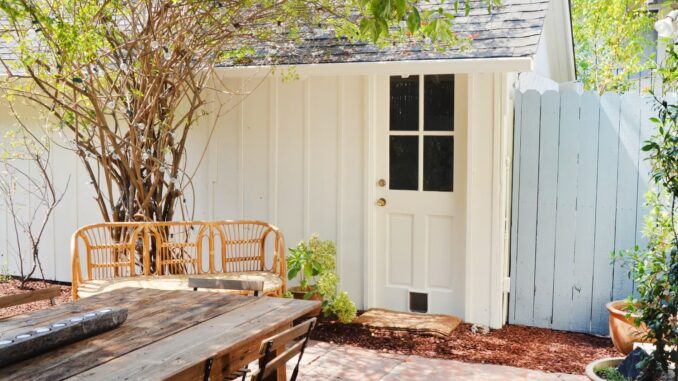
[ad_1]
We independently select these products—if you buy from one of our links, we may earn a commission. All prices were accurate at the time of publishing.
Accessory dwelling units, also known as ADUs, have been steadily rising in popularity for years now, and it’s easy to understand why. When you need more space, they’re a relatively affordable solution that doesn’t disrupt the primary residence. Plus, they offer a significant ROI, whether by way of home value or rental income.
There’s much more to ADUs than meets the eye though, including the formal definition of ADUs versus how you probably think of them, the legal requirements for having them on your property, and much more. Here’s what to know about accessory dwelling units.
“Basically, it’s an extra place to live that’s on an existing property with a primary residence,” says Eric Callahan, president of ADU manufacturer Elbow Room. “Buildings like these that don’t have livable features like a bathroom and kitchen are actually referred to as accessory structures.” Surprised? The phrases are often used interchangeably (including in this piece), but technically, they’re not the same thing.
If you’re purchasing yours from a company that specializes in building structures like these, the price can vary significantly. For example, Elbow Room’s all-inclusive price range is between $26,000 and $199,000 (only the utility hookup charge is excluded). In addition to a water-tight, insulated, electrically wired structure with a finished interior, you also get architecturally stamped plans, a structurally engineered foundation, project management, internal and third-party inspections, and permitting if applicable. Available upgrades include decks, lofts, designer siding, added windows, and designer doors.
Hillbrook Collection’s most popular model, meanwhile, is 9’ by 14’ and starts at $12,950. “We’ve heard from architects that Hillbrook, relative to getting a contractor, can save up to 60 percent,” says founder of Hillbrook Collection Alison Carabasi. “We have a specialized central environment to build them, where we know how to do it really well and are more efficient in doing so.”
What can you do with an ADU?
Put simply, ADUs can be used for nearly any practical purpose. If yours is more akin to an accessory structure, it can be a garden shed, potting shed, art studio, home gym, “granny flat,” home office, pool house, or something else. It’s whatever you can do within four walls and a roof!
Traditional ADUs can also be used as a flexible living space, sometimes known as a tiny home or guest house. “Multi-generational living is on the rise since the cost of home ownership has steadily increased,” Callahan explains. “It’s a great way for families to function as a whole unit while maintaining independence.”
Callahan also recommends using an ADU for additional income, stating that short- and long-term renting will help you quickly recover the expense of building and then make you some serious money going forward. “An ADU can already increase your property value up to 35 percent — imagine creating cash flow on top of that,” she says.
What are some drawbacks of ADUs?
The major drawback of ADUs is just getting them built. Seemingly endless logistics are required, including getting permission from your city/HOA/historical society, finding and managing work crews, and having architectural plans made. This is why companies like Hillbrook Collections and Elbow Room can be incredibly valuable.
Each business is different, so you’ll need to do your research in order to find the right one. For example, according to Carabasi, Hillbrook has a traditional aesthetic and “offers a precise level of detail that you might get from someone like a custom homebuilder.” What they don’t do is create spaces that can actually be lived in like Elbow Room does (though you can install kitchens, bathrooms, etc. to their structures yourself). Location may matter as well: Elbow Room charges an extra fee for delivery 150 miles outside of their homebase of San Antonio, starting at $5,000. You might save a lot of money by going with someone local.
Yes, but the legalities vary from one municipality to another. “Generally, it has to be no more than a certain peerage of your home size and within the limits of your property survey,” explains Callahan. “Surveys spell out the restrictions due to utility lines and easements.”
You also have to get the proper permits, Callahan says. “Without a permit, you can’t claim the square footage of the ADU for your property. It’s like leaving money on the table.” Because proper permitting requires an inspection, it also ensures that you end up with a quality structure. Accessory structures like art studios and home offices often don’t need permitting, but it’s important to look into before you start the process.
“If you want to use your ADU for income generation, you may need to register it with your city and/or county,” she continues. “There may be additional requirements to look out for as well.”
More to know: Depending on where you live, you’ll need to work with your HOA or historical society about the exterior appearance and purpose of the ADU. Property taxes can apply to ADUs as well.
[ad_2]
Source link
Leave a Reply